For Bombardier Recreational Products (BRP) the adventure began more than 60 years ago with the creation and commercialisation of the first snowmobile.
Today, whether it is on snow, on water, on trails or on the open road, this Canadian company with its headquarters in Valcourt, Quebec, promises to ‘move’ people both physically and emotionally with its motorised recreational vehicles.
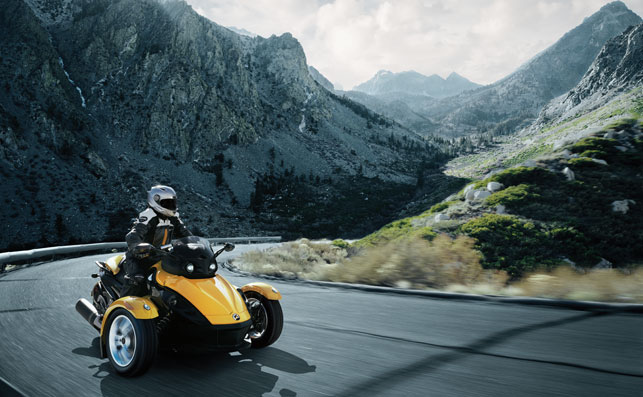
“Design is about seduction,” says Denys Lapointe, executive vice-president of Design and Innovation at BRP. “From a design standpoint, BRP pushes craftsmanship to new limits, giving the utmost attention to detail so that customers can enjoy every thrilling second on one of our products.”
The company claims that innovation is part of its DNA. In the 1960s the head of design Anselme Lapointe and his team were pioneers in the powersports world, launching, amongst other products, the very first Sea-Doo personal watercraft. Following in his father’s footsteps, Denys Lapointe is committed to keeping innovation at the very core of the company’s growth. “Our design philosophy is to create highly innovative, functional and exciting motorised products to exceed people’s recreational needs,” he explains. “We are always looking at challenging current paradigms to create the new paradigm.”
On the road
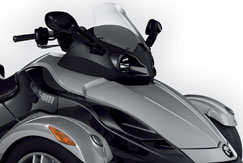
Can-Am Spyder roadster, which marks BRP’s first foray into the on-road vehicle segment
One of its most recent paradigm-shifting products is the Can-Am Spyder roadster, which rolled off the assembly line in Valcourt in September 2007, and marked BRP’s first foray into the on-road vehicle segment. With its unique Y-architecture, having two wheels on the front and one at the rear, the vehicle is described as being part motorcycle, part sports car. Its features include the Vehicle Stability System, engineered in conjunction with Bosch, which includes anti-lock brakes, traction control and stability control systems. It is powered by a Rotax 990cc V-Twin engine, which was designed and manufactured at BRP’s Austrian manufacturing facility.
Having only been on the market a year the Can-Am Spyder is not only catching the eye of consumers but has also caught the attention of Hollywood producer Michael Bay who has confirmed that the roadster will appear in his upcoming film ‘Transformers 2: Revenge of the Fallen’ (due for release in June 2009). In fact, this isn’t the first time BRP products have been featured in a Hollywood film as the Ski-Doo MX Z REV platform snowmobile ‘starred’ in the 2002 James Bond film ‘Die Another Day’.
A hotbed for design
In order to keep introducing innovative products and remain the leader in its traditional markets as well as gaining market share in others, BRP has made some substantial investments in recent years. In 2006 the Advanced Technology Centre (CTA) was opened in Quebec as a centre for research and innovation focusing on the development of new leading-edge technologies.
September 2007 saw the launch of the Regional Innovation Centre in Gunskircghen, Austria, which was built to provide BRP Rotax with a stimulating setting for the development of new engine technologies. In September 2008 a 5,000m2 Design and Innovation Centre was unveiled at the company’s corporate headquarters in Valcourt. The plan to build the Centre Design and Innovation Laurent Beaudoin, named after the company chairman who has had a major role to play in its success over the past 45 years, was revealed in 2007 and is the result of a $15 million dollar investment.
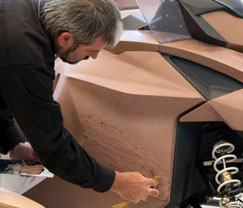
Clay sculpting is amongst the traditional modeling methods still employed
“Innovation has been over the years a key contributor to the growth and success of BRP,” says Lapointe. “We believe that consolidating all design activities into one inspiring centre can only strengthen our creative output and therefore increase our success in the future.”
All stages of the design process from creative thinking to prototyping will take place within the new Design and Innovation Centre. “BRP decided to concentrate in the same facility a large portion of its creative force, a team of 60 individuals ranging from industrial designers, graphic designers, engineers, human factors experts, mechanics, CAD technicians and modellers,” says Lapointe. The building is structured in five sections: the central hall with administrative functions and meeting rooms; two open offices overlooking the very long main studio floor with its adjacent succession of clay rooms; and the basement contains all the shops required to build functional prototypes. “This working environment increases the capacity to allocate temporarily more people to a project and get more creative output and synergy between each design team,” adds Lapointe.
As Lapointe argues, the centre allows for greater interaction between designers and others involved in the design and development process. “The main goal is to bring everybody together to increase the creative output, which ultimately translates into better products that respond to the consumer even better than before,” he says. “So, creating the right environment that fosters creativity is one of the main goals.”
BRP designers never work in isolation purely concentrating on just their specific area. “Being all together will allow the various members of the design and innovation team to use their creative talent to ‘pitch’ or work on more themes than before,” says Lapointe. “In other words, it will be possible for a watercraft designer to propose a concept for the next generation of snowmobile and vice versa. In fact, that’s exactly what we did when we designed the Can-Am Spyder roadster. And we didn’t just invent a vehicle, we created a market.”
Design exploration
The design team use both hard and soft process tools (such as brainstorming techniques) to discover and explore new product opportunities. “They’re also constantly developing new creative approaches to improve the innovation process,” comments Lapointe. The team do not necessarily always carry out consumer research at the start of the design process. “At the beginning, we do unconventional focus groups with consumer observation sessions sometimes with lead user type of individuals when applicable, otherwise we carry out our concept development based on our own hypotheses and validate these hypotheses later with targeted consumers and sufficiently evolved prototypes,” says Lapointe.
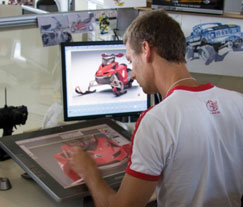
BRP strikes a balance between traditional design and digital design processes
However, when it comes to actually converting ideas and concepts into market ready products, Lapointe doesn’t give too much away on the processes used. “The design process is an integral part of the global BRP new product development (NPD) stage gate process, similar to other stage gate processes that exist elsewhere in other industries, but we also have our own proprietary innovation process that feeds into our typical NPD process. Unfortunately we chose not to reveal too much on the matter but it helps us identify potential new paradigms.”
In order to connect with the consumer, BRP has established an approach that it argues is based on a perfect balance of three key fields of expertise – design, engineering and marketing. So, just as designers don’t work in isolation from one another, they do not operate in isolation from engineers or marketers either. “Several designers, engineers and marketers are involved in our NPD process, where we function based on what we call our triad methodology, where the prime focus of everyone is to find the perfect balance amongst all ingredients that will satisfy and delight the end user,” says Lapointe. “With the triad’s complementarily yet diverging point of views, this brings up very interesting debates, but at the end of the day, we usually obtain the wow factor that makes consumers come back to BRP.”
The role of technology
In the design studio a number of design tools are used including Catia and Rhinoceros 3D for CAD with sketches realised using Adobe Photoshop and Corel Painter. They also use portable 3D scanners – Handyscann – from Creaform to digitalise clay models.
“The main benefits of using the 3D scanner are increased precision and time saving,” says Lapointe. BRP designers use the laser scanner to acquire the x, y, z coordinates of millions of points on a clay model of a watercraft or snowmobile, for instance, and directly generate a polygonal mesh, which is then converted to Class A surfaces.
Over the years, the introduction of such new technologies has obviously had an impact as to how products are developed. “Although the creative process is very similar to what it was, the development process has changed drastically over time and we are very fortunate to have these latest tools to design and develop our products since they are getting more sophisticated and the consumers constantly expect more from us,” says Lapointe.
Global reach
Although all design and innovation is located in Valcourt, some research and development as well as manufacturing takes place at various sites around the world. “The Ski-Doo snowmobile, Sea-Doo personal watercraft and Can-Am Spyder roadster are manufactured in Valcourt,” says Lapointe. “Lynx snowmobiles and our utility Ski-Doo models are manufactured in Rovaniemi, Finland. We manufacture Sea-Doo sports boats in Benton and Evinrude engines in Sturtevant, both in the USA. Our Can-Am all-terrain vehicles are made in Juarez, Mexico and we have a plant in Guangdong, China for our lower hp Evinrude outboards.” So, overall its manufacturing presence spans six countries, its marketing reach extends to over 80 countries and it has over 5,000 dealers and distributors around the globe.
However, as Lapointe argues, you can have all the facilities and tools available to bring products to market but it’s really the people that create. “Ultimately, the creative output is only as good as those who feed it,” he says. With its new design and innovation centre the company is looking to attract even more talented designers. “We are looking far ahead. We need people who are also looking far ahead and who want to share their talents. The Design and Innovation Centre Laurent Beaudoin is sending out a clear message: if you want to have a career in design; if you want to do it in the powersports field; if you want to do it with the best resources and in the best environment in the industry… start looking to Valcourt and contact us.”
A brief history of Bombadier recreational products

Joseph-Armand Bombardier was a mechanic who dreamt of building a vehicle that could ‘float on snow’. In 1937 he designed and produced his first snowmobile in his small repair shop in Valcourt, Quebec and in 1942 he set up I’Auto-Neige Bombardier Limitee in order to build these tracked multi-passenger snow vehicles. However, with the onset of the Second World War he switched gears and developed vehicles for the military. When the war was over, he diversified his business yet again first by producing tracked snowploughs and then by making all-terrain utility vehicles for the forestry, mining and utilities industries. However, Bombardier still dreamt of developing a fast, lightweight snowmobile that could carry one or two people and in 1957, with the development of smaller and more efficient engines, he resumed his efforts to build a ‘miniature’ snowmobile. He worked alongside his eldest son Germain and together they developed several prototypes of a lightweight snowmobile and finally, in 1959, the first Bombardier snowmobile went on sale. Interestingly, the Ski-Doo was originally intended to be named the ‘Ski-Dog’ because Bombardier meant it to be a practical vehicle to replace the dogsled for hunters and trappers. However, a painter accidentally misinterpreted the name and painted Ski-Doo on the first prototype.
Along with snowmobiles, the 1960s saw the launch of the first Sea-Doo personal watercraft. Joseph passed away in 1964 and left the company in the capable hands of his sons and sons-in-law who reorganised and decentralised the company and also changed its name to Bombardier Limited. During the 1970s, the company created further motorised recreational vehicles including the Can-Am brand of off-road competition motorcycles. The 1970s and 1980s also saw the company diversify into railway and aeronautical products and become a multinational corporation known as Bombardier Inc.
On 27 August 2003 Bombardier Inc announced the sale of its Recreational Products division to a group of investors, including the Bombardier family, forming Bombardier Recreational Products (BRP). Today, as a privately held company, BRP is a world leader in the design, development, manufacturing, distribution and marketing of motorised recreational vehicles.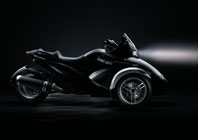
Bombadier on pushing forward its design for powersports






